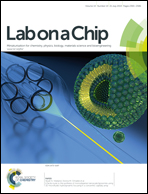Preparation of monodisperse microbubbles using an integrated embedded capillary T-junction with electrohydrodynamic focusing†
Abstract
This work investigates the generation of monodisperse microbubbles using a microfluidic setup combined with electrohydrodynamic processing. A basic T-junction microfluidic device was modified by applying an electrical potential difference across the outlet channel. A model glycerol air system was selected for the experiments. In order to investigate the influence of the electric field strength on bubble formation, the applied voltage was increased systematically up to 21 kV. The effect of solution viscosity and electrical conductivity was also investigated. It was found that with increasing electrical potential difference, the size of the microbubbles reduced to ~25% of the capillary diameter whilst their size distribution remained narrow (polydispersity index ~1%). A critical value of 12 kV was found above which no further significant reduction in the size of the microbubbles was observed. The findings suggest that the size of the bubbles formed in the T-junction (i.e. in the absence of the electric field) is strongly influenced by the viscosity of the solution. The eventual size of bubbles produced by the composite device, however, was only weakly dependent upon viscosity. Further experiments, in which the solution electrical conductivity was varied by the addition of a salt indicated that this had a much stronger influence upon bubble size.


 Please wait while we load your content...
Please wait while we load your content...